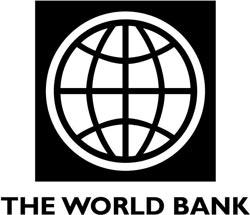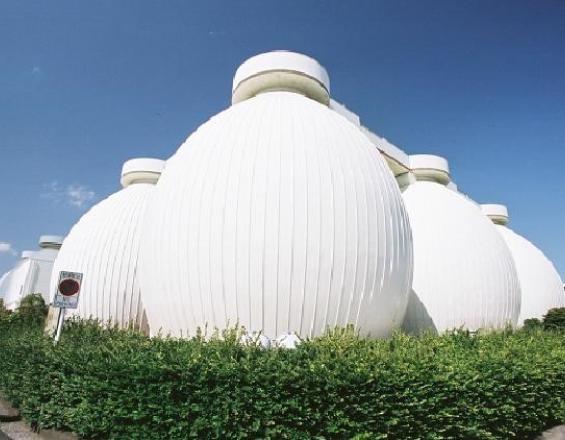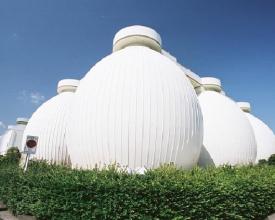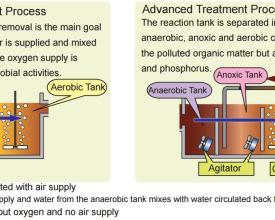
Gestión sostenible de las aguas residuales

El sistema de alcantarillado de la ciudad de Yokohama cubre casi por completo su extenso territorio, con más de 3,5 millones de habitantes. La longitud total de las tuberías de alcantarillado es de unos 11.000 km, lo que equivale a la distancia entre la ciudad de Yokohama y Nueva York (EE.UU.). Las 11 depuradoras de la ciudad, construidas entre 1962 y 1984, tratan diariamente unos 1.500.000 m3 de aguas residuales. El sistema de alcantarillado ha abordado los retos de la sostenibilidad en materia de eficiencia de los recursos, reducción de las emisiones de gases de efecto invernadero (GEI) y reducción del riesgo de inundaciones en el contexto del envejecimiento de la sociedad y la resiliencia nacional. También ha adoptado tecnologías avanzadas de tratamiento para mejorar las condiciones sanitarias y la calidad del agua de ríos y arroyos.
Contexto
Défis à relever
El sistema de alcantarillado se enfrenta a varios retos de sostenibilidad en cuanto a su servicio. En primer lugar, se espera que la ciudad actualice gran parte de sus sistemas de infraestructuras de alcantarillado en los próximos 30 años, ya que la mayoría se construyeron hace más de 20 años. El envejecimiento de las tuberías e infraestructuras de alcantarillado no sólo afecta directamente a la calidad del servicio de alcantarillado, sino que también expone la vida cotidiana y las actividades socioeconómicas de la ciudad a peligros, como socavones en las calles por daños en las tuberías, que es necesario prevenir. En segundo lugar, la ciudad persigue un sistema de alcantarillado sostenible desde el punto de vista medioambiental. Por ejemplo, a pesar de que el sistema cubre completamente el área de la ciudad, sigue habiendo eutrofización en las masas de agua cerradas. Además, la gran cantidad de lodos que se generan cada día en las depuradoras alcanza aproximadamente el 20% del total de residuos industriales.
Ubicación
Procesar
Resumen del proceso
La financiación sostenible es uno de los mayores retos a los que se enfrenta el sistema de alcantarillado en el contexto de una sociedad que envejece. Para reducir el coste total, es necesario gestionar un conjunto de instalaciones de forma sistemática. El reciclaje del agua y los lodos procesados no sólo contribuye a la conservación del medio ambiente, sino que también ayuda a recuperar los costes de mantenimiento y renovación del sistema de alcantarillado. La aplicación de tecnologías avanzadas también mejora la calidad del agua tratada, así como la recuperación de recursos y la generación de energía eléctrica.
Bloques de construcción
Planes de financiación para una gestión sostenible de las aguas residuales
Para hacer frente al envejecimiento de los sistemas de alcantarillado, se ha desarrollado y ejecutado sistemáticamente un plan de renovación teniendo plenamente en cuenta el plan presupuestario. La zona en la que se construyó un sistema de alcantarillado antes de la Segunda Guerra Mundial se designó como zona de renovación de primera fase, seguida de una zona de renovación de segunda fase en la que se construyó un sistema de alcantarillado de 1945 a 1970. Para garantizar el presupuesto para la renovación de la infraestructura de alcantarillado y seguir prestando servicios sólidos, era necesario mejorar las condiciones financieras. Por ejemplo, se fijó el objetivo de reducir la tasa de dependencia de los bonos corporativos para mejorar la base financiera de los servicios de alcantarillado. Además, se introdujo la PFI para reducir el coste del reciclado de lodos. Se ha reforzado la gestión diaria de los sistemas para prolongar la vida útil de las instalaciones y tuberías, y se está creando una base de datos e información sobre los sistemas de alcantarillado.
Factores facilitadores
- Planes sistemáticos para renovar las infraestructuras deterioradas
- Mecanismo financiero para la recuperación de recursos
- Desarrollo de una base de datos e información sobre los sistemas de alcantarillado
Lección aprendida
La financiación sostenible es uno de los mayores retos a los que se enfrenta el sistema de alcantarillado en el contexto de una sociedad que envejece. La supervisión y el mantenimiento periódico de las instalaciones prolongan la vida de las instalaciones de alcantarillado. A la larga, esto reduce el coste total del ciclo de vida del sistema. Además, los planes de financiación mediante la recuperación de recursos y la cooperación público-privada ayudan a recuperar la inversión y el coste de gestión.
Utilización del agua regenerada
Las aguas residuales tratadas se utilizan para diversos fines en la ciudad. Tres plantas de tratamiento de aguas residuales ozonizan el agua tratada, mientras que todas las plantas disponen de instalaciones para filtrar las aguas residuales mediante arena. El agua ozonizada se utiliza para inodoros, pequeños arroyos artificiales y sistemas de aire acondicionado (AC). El agua filtrada por arena se recupera para limpiar las depuradoras y los retretes. Las aguas residuales tratadas generan ingresos al venderse para limpiar las tuberías de desagüe y las plantas de construcción. La calidad del agua regenerada cumple las normas designadas para los distintos usos por el gobierno nacional.
Factores facilitadores
- Tecnologías para limpiar las aguas residuales y utilizarlas con diversos fines
- Mercados maduros para el agua regenerada
Lección aprendida
A medida que el agua se convierte en un recurso cada vez más preciado, el agua regenerada también adquiere más valor. Una vez tratada con las medidas adecuadas, el agua residual reciclada puede ser un recurso útil en diversas ocasiones. Además, los ingresos generados por la venta de agua reciclada a operadores privados pueden destinarse a reinvertir en la mejora o rehabilitación de plantas de tratamiento e instalaciones de alcantarillado para una gestión sostenible.
Utilización de los recursos generados por el tratamiento de lodos
Los lodos generados en el proceso de tratamiento de aguas residuales también se reciclan en la ciudad de Yokohama. Los lodos generados en once plantas de tratamiento de aguas residuales se transportan a dos plantas de tratamiento de lodos y, a continuación, se someten a procesos de espesamiento, digestión y deshidratación. Tras el tratamiento, el peso de los lodos disminuye 400 veces y se convierte en un producto inodoro e higiénico. El gas generado durante el proceso de digestión se recupera como fuente de energía y se utiliza para generar electricidad y como combustible para la incineración en las plantas de tratamiento. Además, las cenizas tras la incineración se han utilizado como materia prima para mejorar el suelo y el cemento.
Factores facilitadores
- Tecnologías para utilizar los lodos procesados
Lección aprendida
En las plantas de tratamiento de aguas residuales se genera una cantidad no desdeñable de lodos, que alcanza aproximadamente el 20% del total de residuos industriales en Japón. El vertido convencional de este subproducto ha venido causando falta de espacio en los vertederos y contaminación ambiental. Los gobiernos locales y los organismos de gestión de aguas residuales pueden disminuir el importante volumen de eliminación final procesando con cautela los lodos y reciclándolos como abono para tierras de cultivo, materiales de construcción y fuente de energía.
Proceso de tratamiento avanzado para mejorar la calidad del agua
El sistema de alcantarillado ha contribuido a mejorar la calidad del agua pública. La tasa de cobertura del alcantarillado pasó del 85% en 1989 al 99,8% en 2013. A los ríos no llegan aguas residuales sin tratar, y la calidad del agua de los ríos ha mejorado significativamente. Los valores de DBO en los principales ríos de la ciudad disminuyeron entre un 40 % y un 87 % en 2013 con respecto a los de 1984. Por otro lado, sigue habiendo eutrofización en masas de agua cerradas como lagos y aguas costeras. Para hacer frente a este problema, la ciudad de Yokohama introdujo tecnología de tratamiento avanzada para eliminar el nitrato y el fósforo que contribuyen a la eutrofización. El número de plantas de tratamiento que aplican el proceso de tratamiento avanzado pasó de dos en 1996 a ocho en 2013, con lo que aumentó la tasa de eliminación de nitrógeno y fósforo.
Factores facilitadores
- Tecnología avanzada de tratamiento para eliminar el nitrógeno y el fósforo de las aguas residuales
Lección aprendida
Las depuradoras no eliminan por completo las sustancias nocivas de las aguas residuales. Los restos de nitrato y fósforo en las aguas tratadas contribuyen a la eutrofización, especialmente cuando se vierten en masas de agua cerradas. Para preservar la riqueza del medio acuático, todas las aguas residuales deben tratarse por medios colectivos o individuales antes de verterse a las masas de agua. Además, la aplicación de tecnologías eficaces y la vigilancia continua son esenciales para mejorar la calidad del agua.
Impactos
Impacto económico: La ciudad está tratando de reducir la fuerte dependencia de los bonos corporativos, y un nuevo objetivo fijado para el actual plan a medio plazo pretende mejorar aún más la situación financiera de la gestión de aguas residuales de la ciudad, tales como medidas de recuperación de recursos para reducir el coste del tratamiento y aumentar los ingresos por la venta de materiales reciclados, la participación del sector privado en la gestión de aguas residuales para la reducción de costes, y la exportación de la experiencia y la tecnología del sistema de alcantarillado de Yokohama (por ejemplo. tecnología de tratamiento de aguas residuales a la ciudad de Batam, en Indonesia, en el marco de un proyecto de la Agencia de Cooperación Internacional de Japón).
Impacto social: El sistema de alcantarillado de Yokohama contribuye a mejorar el saneamiento de la ciudad. Además, los pequeños arroyos en los que se utiliza agua regenerada ozonizada proporcionan excelentes espacios acuáticos y de ocio para los ciudadanos. Los esfuerzos por lograr la sostenibilidad de los sistemas de alcantarillado contribuyen a mitigar las inundaciones durante las crecidas.
Impacto medioambiental: La calidad del agua de los ríos, arroyos y aguas costeras de Yokohama ha mejorado gracias a su sistema de alcantarillado. La mejora de la calidad del agua también se ha traducido en un aumento de la diversidad de peces en los principales ríos. Los estudios han demostrado que peces como el killifish, el salmón y los pececillos de agua dulce han regresado. Alrededor del 20% de las emisiones de GEI de las empresas y servicios gestionados por la ciudad de Yokohama proceden de la gestión de las aguas residuales.
Beneficiarios
- Residentes de la ciudad de Yokohama
- Empresas privadas de Yokohama


